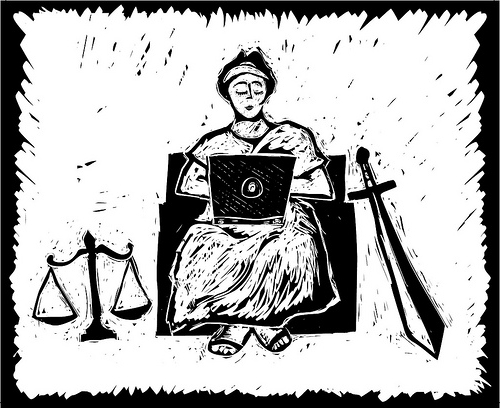This article will examine what principles apply the application of the rule of law, the stage of application of the rule of law, as well as the form of its implementation. The starting point for the implementation of legal norms is lawmaking. When adopting a normative legal act, the legislator must trace its conformity with respect to previously adopted laws and the Constitution. Norms of law are created to regulate relations among subjects of law.
Application of law - definition of a concept

The application of legal norms is the activity of authorized authorities, which is aimed at the adoption of legislative acts by issuing specific requirements.
This type of activity is necessary in cases where it is impossible to fully implement the rule of law. Such cases can be generalized into several groups:
- when obligations and rights do not arise for legal entities or individuals without outside interference of authorities (for example, a draft for military service);
- if it is necessary to establish the absence or presence of certain legal facts or register any legal actions (for example, certification of a copy of the transaction);
- when the dispute between the subjects of legal relations cannot be resolved without the intervention of authorities (divorce with the division of property);
- when it is necessary to establish the measure and type of responsibility for the offender.
Law enforcement as a kind of legal relationship
Since the application of the rule of law is a relationship between government bodies and its entities aimed at identifying law enforcement relations, the legislator is not limited to dividing legal relations by their law-making and service role. Of all existing legal norms, one should single out those that are functionally designed for the direct regulation of legal activity. These norms include branches of law that are implemented as part of the enforcement process.
There are also stages of application of the rule of law and their features, which have certain specific features. Law enforcement relations are terminated, changed and arise as a result of the onset of legal facts, which, in turn, are presented in the form of legal structure characterized by public-power actions.
Law Enforcement - Legal Nature

Theorists are most interested in law enforcement relations, as well as the stages of application of the rule of law. TGP equates law enforcement with procedural relations, which include both the substantive side of regulation and the procedural and procedural aspects.
Material standards are aimed at regulating relations between legal entities and authorities. The subject of regulation is the organizational relationship that develops in the process of government power.
Law enforcement relations are defined as a special kind of public relations, within the framework of which the exercise of state powers, as well as the implementation of specific legal situations.
Signs
The stages of application of the rule of law have a number of features:
- The application of law involves the activities of state bodies.
- They are authoritative in nature, since decisions are made through the unilateral expression of the will of a state body.
- Law enforcement complies with all regulatory acts, as well as the Constitution.The need to comply with procedural rules in law enforcement follows from compliance with the requirements of state coercion, as well as legality. The result of such activities is the issuance of specific requirements that define the obligations and rights of participants in legal relations.
- Law enforcement is based on state legal norms.
Application of law - stages

The stage of application of the rule of law is a complex and at the same time multi-stage activity. There are 4 stages of law enforcement:
- Clarification of the circumstances of the case.
- Establishing the basis for the case.
- Making a legally relevant decision in the case.
- Bringing the decision to all interested public and state bodies and their officials.
Case Study Stage

The establishment of the circumstances of the case is a preparatory stage, due to which the application of the rule of law is carried out. The stages of application are expressed as significant facts of the event to which the legal rules apply.
Actual circumstances act as legally significant only if the legal norm associates with them the termination or change of legal relationship, the nature and extent of the sanctions. In legal practice, they are referred to as the main facts or circumstances to be proved (for example, the fact of a murder).
Full credibility and proper legal consolidation are the principles that characterize the application of the rule of law. The stages of application are expressed by establishing evidence in the case. Evidence is data regarding factual circumstances, which include arguments in disputes, logical arguments.
Sources of information on the actual circumstances of the case require procedural certification or consolidation. For example, a protocol with a list of items found during a search is mandatory signed by witnesses. The law establishes the universal accessibility of evidence, but if it is illegally obtained, it is considered invalid (for example, illegal wiretapping of a telephone conversation).
The establishment of evidence is the preliminary stage by which the application of the rule of law is carried out. The stages of application are presented in the form of logical activity of the subjects, which is aimed at establishing evidence, their research and evaluation.
If the investigation of the case did not immediately reveal all the legally significant facts and events that are relevant to the offense, after the lapse of time it will be much more difficult to do. The more circumstances and facts will be revealed at the first stage of law enforcement, the faster all subsequent stages will be realized.
Establishing the legal basis of the case

Establishing the basis for the case is the second stage through which the application of the rule of law is carried out. The application stages are a structured activity of the authorities, which involves:
- The choice of the norm, which is subsequently to be applied.
- Checking the text of a normative act containing the necessary norm.
- Verification of its authenticity and patterns of action in space, in a circle of persons and time.
- Understanding the content and meaning of the norm.
The choice of the rule of law is carried out after establishing the nature of the circumstances in question. The stages of the process of applying the rule of law are primarily aimed at determining the branch of legislation that regulates specific legal relations. After that, the type of relationship is established, under which a certain norm is selected, providing for a specific life situation.
Having chosen the rule of law, the legislator checks the authenticity of the text of the legal act, which contains the precept. Then it turns out what changes were made to the normative act.After these actions, a “criticism” of a legal norm is mandatory, which involves a detailed and comprehensive check of the possibility of applying the rule of law to a specific life case. Criticism, in turn, is divided into “lower” and “higher”.
Thanks to the "highest" criticism, the lawfulness of the law is checked and contradictions are established. It is also checked whether he is suspended in action, whether the circle of his influence extends to the legal relations that have arisen. If the rule of law does not pass the "highest" criticism, its application is called into question. It is impossible to apply a legal norm that was adopted after the onset of regulated legal relations.
“Lower criticism” refers only to the legislative text. It is aimed at evaluating the verbal presentation of the norm, as well as at eliminating errors (typewritten or printing) that were made during the recruitment process.
The first stage of the application of the rule of law can be briefly described as a preliminary legal qualification, at the end of which a circle of circumstances in the case is to be determined. The final qualification is carried out when formulating the final conclusion regarding legal norms that fall under a specific life case.
At the last stage of the enforcement process, the meaning and content of the legislative act, in other words, the interpretation of the rule of law is to be clarified. This type of activity is carried out by all participants in the legal relationship, since the rule of law is abstract in nature, although it applies to a particular life event. Also at this stage of enforcement it is necessary to establish all the auxiliary rules, which subsequently will help to clarify the basic rule of law.
Adjudication

The final stage of the process of applying the rule of law is the adjudication of the case. On the formal side, this stage is expressed in the form of an inference in which the facts are subject to a legal norm. In this situation, the court or other enforcement agency, by virtue of its authority, applies the general rules to prevailing life circumstances.
The result of the decision of the case is an imperative order or order, which is presented in documentary form (act, sentence, decision, conclusion). The state imperious command has a dual function:
- Legal significance consists in stating or acknowledging the existence of certain facts in the case, as well as their legitimacy.
- After the decision is made, there is a need for additional activities by the competent authorities aimed at the execution of the court decision, which was imposed a penalty.
- The decision in the case takes a subordinate position in relation to other acts of law-making, and is also based on the rules of law issued for the purpose of individual influence.
- The authorities adopt legally relevant documents that are specific to this stage of application of the rule of law (examples: the main act securing the decision on the case, and the auxiliary act - taken in establishing factual circumstances during the trial).
The decision in the case is considered one of the most important acts for two reasons:
- decision makers are responsible for their actions to citizens and the state;
- the decision plays a decisive role in the fate of the entities to which the normative act applies.
Making the right decision provides:
- strengthening law and order in general;
- supporting the authority of the state in society;
- building respect for the law;
- human rights protection.
In practice, all stages of the application of law are in inextricable unity with each other, and are also often expressed through identical actions. AT practice stages of the proceedings are presented in civil and criminal proceedings.
In the criminal sphere, such stages of enforcement are presented as:
- Trial.
- Preliminary investigation.
- Execution of the sentence.
In civil office work, the following stages are distinguished:
- Judicial training.
- Dispute Resolution
- Execution of the decision.
But, despite the division of law enforcement stages by industry, they all have a single goal - establishing the circumstances of the case and making a legally significant decision.
Bringing the decision to the attention of all interested public and state bodies, as well as officials

The competent authority is not only involved in making an authoritative decision in the case, but also brings information about its adoption to interested parties. Such actions are carried out both after the decision is made, and after a certain time period has passed.
The decision taken determines the fate of the subjects involved in the case, affects the actual circumstances of the case, establishes the duties and rights of the persons participating in the proceedings, and fixes sanctions against offenders.
At this stage, the enforcement process ends, after which comes the implementation of the decision.
Conclusion
The application of law is a special activity of the competent authorities, which is aimed at the implementation of legislative norms through the issuance of individual requirements.
The main stages of application of the rule of law are carried out in four stages:
- Determination of the legal basis for the case.
- Establishing the circumstances of the case.
- Decision making.
- Bringing the established decision to the attention of all interested public, state bodies, as well as officials.
All four stages are united by one specific feature, which is expressed in a legal assessment of the totality of circumstances in a case by assigning a specific case to the necessary legal norm.
Law enforcement is required to comply with the basic requirements of legality, expediency, fairness and soundness.
